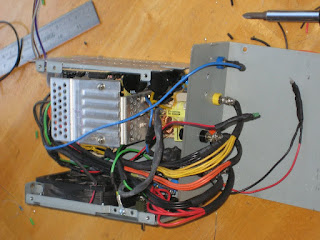First thing to do was pick the book that I wanted to use. I thought A Light in the Attic would be a perfect book because of the title. Also, I was guessing that there were a zillion copies out there, so I could find it used for cheap. So I ordered a copy off half.ebay.com. It was a nice enough book, but maybe a little thin. But I figured I could make it work.
On my first attempt at this project, I tried building the lamp the same way that I read in the guide. Where you remove the pages of the book completely and replace it with a wooden frame wrapped in cloth. Maybe I wasn't using the right materials, and I didn't have the best tools. But I wasn't happy with how it was looking. So before committing my electronics and more time to it, I decided to scrap it and start over.
The second time I went with just hollowing out the actual pages of the book. That way there would be no mistaking that this was indeed a book.
I knew that I was going to be using 1/8" think acrylic for the face of the lamp. So I measured out the top 1/8" worth of pages. The rest I glued together using a mix of water and Elmer's glue (standard white glue) I brushed this on the edges of the pages. I used wax paper between the glued pages and the rest of the book to keep the rest from getting stuck together. Then used a stack of books to press everything together and let it dry.
 |
| After gluing pages together |
 |
| Before cutting out pages |
 |
| Midway through the bottom section of pages |
Now it was time for the electronics. I had a spare 12v A/C adapter, so I ordered a power connector that it could fit into. I drilled a hole in the spine of the book at the base and installed the connector with hot glue. Now I could get power into my book.
Next I cut a small notch on the right hand side of the book to place a magnetic reed switch. This switch had two connections. One for normally open and the other for normally closed. I needed normally closed so that when the book was open the light would come on. And you could turn the light off by simply closing the book. I installed a tiny magnet from my fridge into the inside cover of the book to line up with the switch.
So now I had a working switch and power. Time to install the lights. I had ordered a cheap, one meter strip of soft white LEDs off of ebay. This was enough to run around the inside edge of the book as well as place a few more on the inside of the back cover. I wanted to use every bit of the strip I could, to make the book light as bright as possible. So I split the strip in a few places and soldered wires to keep the connection going to all the lights. Plenty of hot glue to hold everything together and and the electronics were complete.
 |
| Electronics installed |
 |
| Finished book light with no power |
 |
| Finished book light powered on |




























